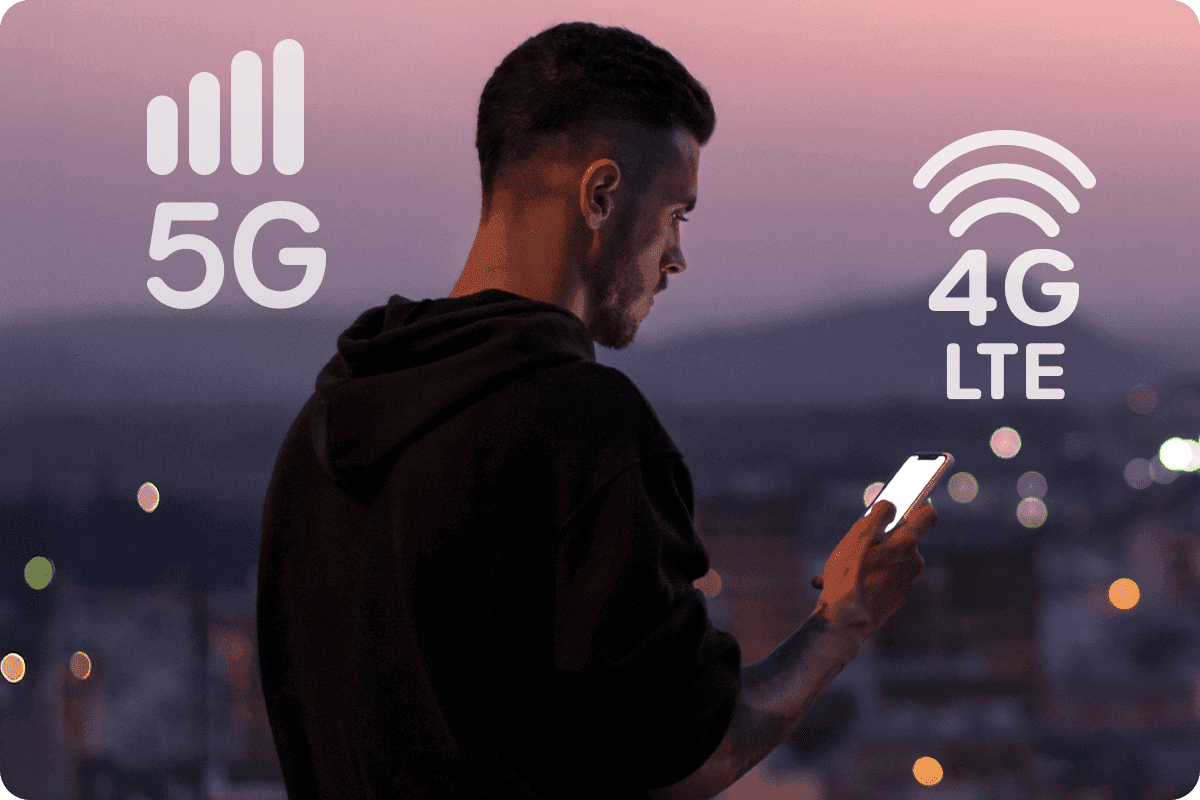Understanding Mobile Network Technologies: 4G, 5G, and LTE Explained
By: Vincent Totino
Read Time: 8 min.
September 25, 2025
Mobile network technologies have significantly evolved over the years, with 4G, LTE, and 5G representing key stages in this evolution. With this new mobile technological evolution, and while they are often interchangeable, 4G and LTE, there are distinct differences in their capabilities, speed, latency, and applications Knowing the differences between the 4G and LTE will allow you to understand the benefits of 5G, and how crucial it is in navigating today’s connected world.

What Is 5G vs 4G Mobile?
What Are the Benefits of 5G?
What is 4G (Fourth Generation)?
4G is the fourth generation of mobile phone technology and builds upon the advancements of 3G. It offers much faster speeds and improved internet access for mobile devices, tablets, and laptops. 4G has become a cornerstone of modern cellular telecommunications, revolutionizing how people connect and communicate. It is essentially a radio system where masts or base stations broadcast signals, and 4G-enabled devices communicate with these base stations to relay data.
One key aspect of 4G is its “all-IP” (Internet Protocol) based standard for both voice and data, which makes it more efficient to operate compared to 3G, which used separate systems for voice and data.
What is LTE (Long-Term Evolution)?
LTE stands for "Long-Term Evolution" and is often referred to and associated with 4G LTE. It is a standard for wireless broadband communication and is considered a transitional 4G technology, sometimes called 3.95G. LTE was developed to increase the capacity and speed of wireless data networks, and it forms the backbone of 4G networks.
LTE significantly improves 3G network performance by offering lower latency and increased throughput. It operates on a separate spectrum from 3G and requires newer hardware. LTE supports data, voice (VoLTE), instant messaging, and video over a single interface. While 4G is the generational standard, LTE is the specific technology that enables 4G speeds and capabilities.
What is 5G (Fifth Generation)?
5G is the fifth and latest generation of mobile network technology. Its primary goal is to not only offer significantly faster speeds than 4G/LTE but also to enable a wide range of new applications by providing ultra-low latency, massive capacity, and enhanced reliability.
5G is the foundation for the next wave of innovation, designed to connect billions of devices and transform industries.
The key advantages of 5G include:
- Higher Speeds: Download speeds can be up to 100 times faster than 4G.
- Lower Latency: The time it takes for data to travel from your device to the network is drastically reduced. This is crucial for real-time applications.
- Massive Capacity: 5G can connect a million devices per square kilometer, enabling large-scale IoT networks.
4G Vs. 5G: Understanding the Key Differences
Both 5G and 4G utilize similar technologies that are transmitted based on radio signals. Fifth generation technology began early deployment in the 2010s but did not reach peak popularity and performance until the 2020s. The difference lies with 5G’s ability to use a wider range of frequencies, allowing data to travel stronger and faster. 5G boasts faster network speeds, enhanced real-time communication capabilities, less clogging, and slowdowns.
The table below shows a breakdown of differences between 4G and 5G performance. It includes the following information:
| Characteristics | 4G | 5G |
|---|---|---|
| Average Download Speed | 35 megabits per second (Mbps) | 50 Mbps to 3 gigabytes per second (Gbps) |
| Latency | 50 milliseconds | 10 milliseconds |
| Bandwidth/Capacity | Limited to 600 MHz–2.5 GHz | Substantially more capacity across three different ranges |
| Availability | More readily available across the country | Strongest in large cities and currently rolling out nationwide |
What is LTE?
Is 5G Better Than LTE?
Is All 5G the Same?
What 5G Does Optimum Mobile Offer?
The Advantages of The 5G Network For Mobile
5G introduced 5G New Radio (NR) which sought to replace LTE. It was modeled off LTE’s best features and then introduced brand new benefits such as improved energy savings and enhanced connectivity. 5G can operate on a new, high-frequency spectrum called a millimeter wave (mmwave.) This operates on wavelengths between 30 GHz and 300 GHz, in comparison to the 4G LTE’s wavelengths of under 6 GHz.
In fact, 5G technology has greater variation than any previous generation. One of the reasons is due to 5G being able to operate in a wider range of frequencies. Whereas 4G works within 600 MHz to 2.5 GHz, 5G has three main ranges: low, medium, and high band frequencies. Because of this, devices and operators will be able to offer and reach people in different ways depending on their location and service plan.
Optimum Mobile is a leading provider of 5G. Our mobile service runs on the T-Mobile 4G LTE and 5G networks, the largest 5G service compared to Verizon and AT&T. Our goal is to make your life easier with uninterrupted, super-fast service no matter how many people are in your plan.
Our plans are designed to go with the flow of your changing needs. We offer three mobile data plans with different data capacities based on what you need. Choose between one, five, or unlimited gigabyte plans to fit your lifestyle. Need to change your plan? Do it at any time—there’s no catch. And 5G access comes with every plan so that you can be confident in great service powered by the T-Mobile network.
You will, however, need a 5G-ready phone to take advantage of the largest 5G network. Luckily, we’ve got you covered withe latest 5G-ready phones like the Apple iPhone 17, the Samsung Galaxy S25, or the Motorola moto g stylus.
Just as technology is always advancing, there will be a 6G. It will be even faster and more dependable than 5G, operating with extremely low latency and high download speeds. That means even better-quality calls, browsing, and streaming than ever. It also means better location-based uses like GPS.
The next generation of cell service will let you take even better control of your life and data. And it all starts with Optimum Mobile through T-Mobile’s network. Join the journey with 5G today and get the best service for the best prices.
What’s Next for Networks—Will There Be a 6G?
How 5G and AI are Revolutionizing Connectivity*
While 4G, LTE, and 5G are often discussed as separate technologies, the future of mobile networking, particularly with 5G, is deeply intertwined with Artificial Intelligence (AI). 5G technology provides the foundational infrastructure such as, blazing-fast speeds, ultra-low latency, and massive capacity that allows AI applications to operate in real-time. In turn, AI optimizes and manages the complexity of 5G networks that creates a powerful feedback loop: 5G fuels AI innovation, and AI makes 5G networks smarter and more efficient.
AI's Role in 5G Network Optimization
- Intelligent Network Automation: AI algorithms can predict network traffic patterns and can automatically re-route data to prevent congestion and ensure consistent performance.
- Predictive Maintenance: AI can analyze network data to identify potential hardware failures or service disruptions before they occur.
- Enhanced Energy Efficiency: AI can analyze usage patterns and shut down underutilized network elements during off-peak hours. This allows for energy conservation and operational cost reduction.
- Cybersecurity: AI-powered systems can monitor network traffic in real-time to detect and block malicious attacks and fraudulent activity with high speed and accuracy.
5G's Role in Enabling AI Applications
- Edge Computing: 5G's low latency allows data to be processed closer to the source (at the "edge" of the network), which is critical for real-time AI applications like autonomous vehicles.
- Internet of Things (IoT): 5G's ability to connect upwards of a million devices per square kilometer enables large-scale IoT deployments. AI can then analyze the vast amounts of data generated by these devices to power smart cities, industrial automation, and remote healthcare.
- Immersive Experiences: The high bandwidth of 5G makes high-definition augmented reality (AR) and virtual reality (VR) applications possible. AI enhances these experiences by personalizing content and enabling real-time interactions.
Frequently Asked Questions
Is 5G really better than 4G?
Yes, 5G outperforms 4G with faster download speeds, less latency, and more bandwidth.
Will 4G be phased out?
As new technologies (like 5G) emerge, older technologies are phased out. Eventually, 4G will be an obsolete mobile technology. Even 5G will be replaced (sometime in the future) with 6G. Technology constantly evolves.
Do I need to upgrade my phone to 5G?
Newer phone models offer 5G compatibility. However, some older phones also are compatible with 5G. Reach out to your service provider to ensure your phone is compatible with 5G.
Is switching to 5G worth it?
Yes, 5G is faster, offers less latency, and gives users more bandwidth.
Should I get a 4G or 5G phone?
Newer phone models are compatible with the 5G network. If you’re in the market for a new phone, choose one that offers 5G compatibility.





